Aloidendron tongaense
Aloidendron tongaense (Van Jaarsv.) Klopper & Gideon.F.Sm.
Family: Asphodelaceae
Common names: Tonga tree aloe (Eng.); Tonga boomaalwyn (Afr.)
Introduction
A medium-sized tree-aloe endemic to the coastal forests in northern Zululand and southern Mozambique. It has showy, curved, orange flowers, and grows well in sandy coastal regions.
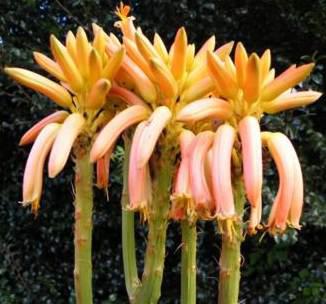
Description
Description
Aloidendron tongaense is a fork-branched, succulent tree, up to 8 m high and about the same width, with a rounded crown. The main trunk is stout and up to 800 mm in diameter at the base. The leaf-bearing branches are about 30 mm in diameter. The bark is grey. Its roots are fleshy and about 33 mm in diameter in mature plants.
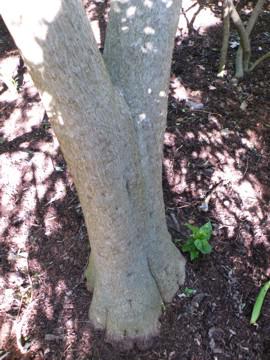
The leaves, about 20, are carried in rosettes at the branch ends. These are firm, leathery and the upper portion deeply channelled. The lower suface is rounded and the leaf-margin with small teeth, 2 mm long and 5–10 mm apart. The leaf tip is sharp (acute). The older leaves are deciduous from the base.
The inflorescence is branched like a candle-stick (candelabriform) and up to 350 mm tall and about 190 mm in diameter. The racemes are 40–60 mm long and laxly arranged, ascending, with yellow buds. The yellowish orange, tubular flowers are curved and 47–50 mm long, 8– mm in diameter, with slightly protruding, yellow anthers, with a slightly swollen base and on pedicels, 10–14 mm long. These are pendent when the flowers open. The fruiting capsules become erect after flowering. The seeds are flattened, winged and about mm in diameter. Flowering time: mainly autumn (April–May in the southern hemisphere).
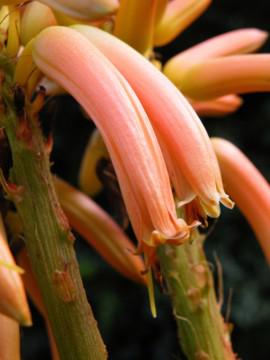
Aloidendron tongaense is closely related to A. barberae and A. eminens. From these it is immediately distinguished by its yellowish orange curved flowers 47–50 mm long. Aloidenron barberae has distinctly shorter, pink flowers, which are not curved. A. barberae is our largest tree aloe (up to 19 m tall) from montane and riverine valleys in the eastern parts of South Africa.
Conservation Status
Status
Aloidendron tongaense is fairly common in Sand Forest and consequently it was not taken up in the Red List of South African plant species (Raimondo et al. 2009).
Distribution and habitat
Distribution description
AloIdendron tongaense is known only from Sand Forest in Tongaland at Kosi Bay in South Africa as well as adjacent territory in southern coastal Mozambique. At Kosi Bay along the northern border of KwaZulu-Natal, plants were observed in warm, humid, subtropical conditions, at an altitude of 5–30 m. The plants grow scattered in sandy soil. Rainfall in the region is high, 1 250–1 500 mm per annum, and it is mainly experienced in summer. Common associated forest tree species include: Albizia adianthifolia, Barringtonia racemosa, Clausena anisata, Dracaena hookeriana, D. reflexa, Drypetes natalensis, Ficus bubu, F. craterostoma, F. tremula, F. trichopoda, Hymenocardia ulmoides, Ochna natalitia, Oxyanthus latifolius, Phoenix reclinata, Raphia australis, Strelitzia nicolai, Syzygium cordatum, Trichilia dregeana, Vepris reflexa and Voacanga thouarsii.
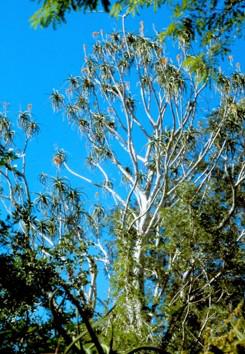
Derivation of name and historical aspects
History
The specific Latin epithet tongaense, refers to Tongaland in northern, coastal Zululand. This species was named Aloe tongaensis by the author in 2010, in the South African succulent and aloe society magazine, Aloe. In the past, this species was known as a coastal form of Aloe barberae. The genus Aloidendron was established by Ronel Klopper and Gideon Smith in 2013 as a result from DNA studies by Olwen Grace at the Royal Botanical Garden, Kew, to accommodate all the tree aloes with forked (dichotomous) branching (leaves deciduous from below). The following six species were transferred to that genus, namely Aloidendron barberae, A. dichotomum, A. eminens, A. tongaense, A. ramosissimum and A. pillansii. The related fan-aloe, previously known as Aloe plicatilis from the Western Cape, also has branches which fork, however, with leaves which remain opposite (distichous), was placed in a genus of its own, Kumara plicatilis.
Ecology
Ecology
Aloidendron tongaense is pollinated by sunbirds and the seeds are clearly wind-dispersed. Seeds ripen in late summer and autumn coinciding with the rainy season.
Uses
Use
Apart from its horticultural use, there are no recorded uses.
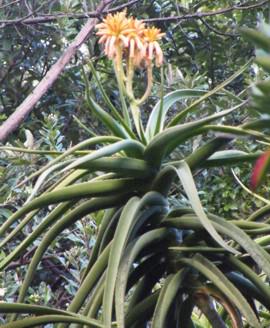
Growing Aloidendron tongaense
Grow
Aloidendron tongaense is a small, fairly fast-growing, ornamental tree, with horticultural appeal. It is easily propagated by branch ends (branch cuttings) or seed. If grown in shady conditions, the leaves tend to be larger. Plants prefer a mineral-poor, slightly acidic, sandy soil.
Aloidendron tongaense adapts well in cultivation and does best in coastal or semi-coastal gardens or as a container plant (Van Jaarsveld 2010). It grows well in other parts of the world or similar climates where frost is absent or light. The plants are also popular in California, where it is grown as a feature plant. It also grows well in Mediterranean-type gardens in other parts of the world. Plants grow in full sun or light shade, and should reach flowering size within about eight years. To obtain pure seed, it is best to cross-pollinate from two individuals. This can be accomplished with a sharpened match stick and by transferring the pollen from a genetically different plant to the stigma of another of the same species, therefore ensuring that the species breeds true.
Aloidendron tongaense seed should be sown preferably during the warmer months, in a shady position. Cover with a thin layer of slightly acidic sand, and keep moist. Germination is usually within three weeks. Seedlings grow slow and are best planted out when large enough to handle.
Propagation from stem cuttings is best undertaken in spring. Allow the cutting to form a heel, by placing it on a dry window sill for a week. Cuttings are best rooted in containers in a well-drained medium, such as sand. Once rooted, they can be planted in individual containers and kept until well established.
Best to feed plants with an organic feeding (compost or any other liquid fertilizer). Aloidendron tongaense can be watered at any time of the year, however, watering should be reduced in winter.
References
- Grace, O.M., Klopper, R., Smith, G.F., Crouch, N.R., Figueiredo, E., RØnsted, N.E. & Van Wyk, A.E. 2013. A revised generic classification for Aloe (Xanthorrhoeaceae subfam. Asphodeloideae). Phytotaxa 76,1: 7–14.
- Manning, J. et al. 2014. A revised generic classification for Aloe (Xanthorrhoeaceae subfam. Asphodeloideae). A molecular phylogeny and generic classification of Asphodelaceae subfamily Alooideae Systematic Botany 39(1): 55–74.
- Mucina, L. & Rutherford, M.C. 2006. The vegetation of South Africa, Lesotho and Swaziland. Strelitzia 19. South African National Biodiversity Institute, Pretoria.
- Reynolds, G.W. 1950. The aloes of South Africa. Trustees of the Aloes of South Africa Book Fund, Johannesburg.
- Reynolds, G.W. 1966. The aloes of tropical Africa and Madagascar. Trustees of the Aloesof South Africa Book Fund, Mbabane.
- Raimondo, D., Von Staden, L., Foden, W., Victor, J.E., Helme, N.A., Turner, R.C., Kamundi, D.A. & Manyama, P.A. (eds) 2009. Red list of South African plants. Strelitzia 25. South African National Biodiversity Institute, Pretoria.
- Van Jaarsveld, E.J. 2010. Water wise gardening. Struik, Cape Town.
- Van Jaarsveld, E.J. 2013. Aloe tongaensis, a new species from Tongaland, KwaZulu-Natal (South Africa), and a new sectional arrangement of the tree aloes Aloe 47,3: 64–71.
Credits
Ernst van Jaarsveld
Kirstenbosch National Botanical Garden
January 2015
Plant Attributes:
Plant Type: Succulent, Tree
SA Distribution: KwaZulu-Natal
Soil type: Sandy
Flowering season: Autumn
PH: Acid
Flower colour: Yellow, Orange
Aspect: Full Sun, Shade, Morning Sun (Semi Shade), Afternoon Sun (Semi Shade)
Gardening skill: Easy
Special Features:
Horticultural zones







Rate this article
Article well written and informative
Rate this plant
Is this an interesting plant?
Login to add your Comment
Back to topNot registered yet? Click here to register.